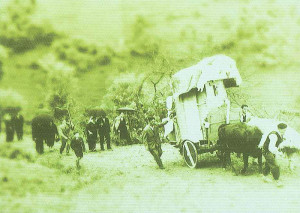Marriage is together with birth the most celebrated life-circle rite. There are numerous rituals and ceremonies associated to marriage. Some of them start in the previous days to the marriage, such as deiuneak or the proclamations of the wedding; the ceremony held on the day the boyfriend was introduced to the girlfriend’s family or botagaba; the meeting or aurpegi-ikustea held in order to bring both families closer to each other, to request the girl’s hand in marriage, to detail the terms of the promise of marriage and to exchange the wedding presents; the stag party or farewell feast enjoyed by the boyfriend and his group of friends (later girls began to hold a hen party); the serenading of the couple to get married; the transfer of the bride’s belongings…
The wedding consisted of two differentiated parts: the religious ceremony and the subsequent festive events. The former did not have the importance it nowadays has. It used to take place on a working day. Just a few guests attended after stopping their work not longer than necessary. On the wedding day, a meal was given in either the groom’s or the bride’s house to willingly receive the partner. If the bride was the guest, she would be warmly embraced as the new housewife.
Marriage was more often than not a matter concerning young girls and boys. It was the youth who walked the bride and the groom to church cheering up the atmosphere with music and rockets. The witnesses were normally chosen amongst the friends of the spouses.
As time wore on, other groups of people joined the former group of young friends. As well as the household members, relatives from further away started to be invited to the wedding, and nowadays the number of guests has considerably increased. In the past the guests used to go to the groom’s or the bride’s house in the morning of the wedding day to head for church all together. Before setting off the family offered them a little snack prior to breakfast. The journey from the house followed fixed paths and tracks, elizbidea, leading to church.
In the past the blessing to unite man and woman in marriage was given at the church door, and the wedding coins and rings were blessed there too. That was the designated place to exchange vows and take oaths. From the 1950s onwards, the ceremony started to be held inside the church, in front of the main altar. At mass the newly married were joined under a wedding wrap.
It arouses a great deal of curiosity to see how husband and wife walk out of church. They are often applauded and wished happiness, and sometimes a dance is performed in their honour and rockets are fired. Throwing rice at the newlyweds as they exit the celebration is a practice more lately introduced.
In some cases the wedding banquet was held on the Sunday after the wedding day, once the married couple returned from a short wedding trip. On that day the young wife took possession of the seat at the symbolic grave of her family-in-law at church and was from then on responsible for the offerings to the deceased members of the household.
Depending on the social class and economical resources of the families, the wedding reception could last from one to three days. The farm animals to be served at the banquet were killed on the eve. The women of the household prepared the food and arranged the dining room with the help of the neighbours. Since the 1950s, rather than the house, restaurants have become more popular venues to hold the party.



